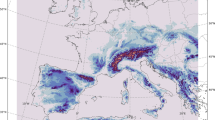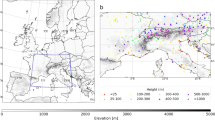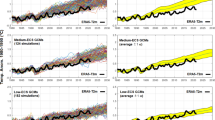Summary
The characteristics of a strong European summertime cold front are investigated using the wealth of synoptic observations, which were analysed by the dynamical initialization scheme of an operational meso-scale model. The study was also extended to forecasted fields.
Cross-sections perpendicular to the front, covering a dormain of more than 2000 km in the horizontal and 10 km in the vertical direction, bring out the basic parameters (as potential temperature and the components of the geostrophic and ageostrophic wind vectors), the ageostrophic crossfrontal circulation and all cross-frontal frontogenesis terms.
None of the many frontogenesis terms plays a dominant role, there is a concerted action of geostrophic and ageostrophic deformation and shear, of tilting and diabatic sources in producing a rather complex structure of total frontogenesis. The cross-sectional fields of all presented terms strongly underline the fact, that a front is not a line of discontinuity but a rather wide three-dimensional field phenomenon.
Similar content being viewed by others
References
Baldwin, D., Hsie, E. Y., Anthes, R. A., 1984: Diagnostic studies of a two-dimensional simulation of frontogenesis in a moist atmosphere.J. Atmos. Sci. 41, 2686–2700.
Bannon, P. R., Mak, M., 1986: A diagnosis of moist frontogenesis with an analytic model.J. Atmos. Sci. 43, 2017–2022.
Eliassen, A., 1962: On the vertical circulation in frontal zones.Geof. Publ.,24, 147–160.
Ewenz, C. M., 1993: Die Rolle der Feuchte bei frontogenetischen Prozessen.Ber. Dtsch. Wetterdienstes,187, 186 pp.
Ewenz, C. M., Kraus, H., 1990: An analytical exercise to elucidate quasi-geostrophic frontogenesis.Meteorol. Atmos. Phys.,42, 179–196.
Hoskins, B. J., 1982: The mathematical theory of frontogenesis.Ann. Rev. Fluid Mech.,14, 131–151.
Hoskins, B. J., Bretherton, F. P. 1972: Atmospheric frontogenesis models: Mathematical formulation and solution.J. Atmos. Sci.,29, 11–37.
Hoskins, B. J., Draghici, I., Davies, H. C. 1978: A new look at the ω-equation.Quart. J. Roy. Meteor. Soc. 104, 31–38.
Hsie, E. Y., Anthes, R. A., Keyser, D., 1984: Numerical simulation of frontogenesis in a moist atmosphere.J. Atmos. Sci.,41, 2581–2594.
Hsie, E. Y., Anthes, R. A. 1984: Simulations of frontogenesis in a moist atmosphere using alternative parameterizations of condensation and precipitation.J. Atmos. Sci.,41, 2701–2716.
Huntrieser, H., Schiesser, H. H., Waldvogel, A. 1994: The synoptic and mesoscale environment of severe convective activity in Switzerland. Proceedings of the international symposium ‘The Life Cycles of Extratropical Cyclones’, Bergen, 27 June to 1 July 1994, Vol. III, 101–106.
Keuler, K., Kerkmann, J., Kraus, H., Schaller, E., 1992: Orographical modification and large-scale forcing of a cold front.Meteorol. Atmos. Phys.,48, 105–130.
Keyser, D., Pecnick, M. J., 1985a: A two-dimensional primitive equation model of frontogenesis forced by confluence and horizontal shear.J. Atmos. Sci. 42, 1259–1282.
Keyser, D., Pecnick, M. J. 1985b: Diagnosis of ageostrophic circulations in a two-dimensional primitive equation model of frontogenesis.J. Atmos. Sci. 42, 1283–1305.
Keyser, D., Pecnick, M. J., 1987: The effect of along-front temperature variation in a two-dimensional primitive equation model of surface frontogenesis.J. Atmos. Sci.,44, 577–604.
Keyser, D., Reeder, M. J., Reed, R. J., 1988: A generalization of Petterssen's frontogenesis function and its relation to the forcing of vertical motion.Mon. Wea. Rev.,116, 762–780.
Koch, S. E., Kocin, P. J. 1991: Frontal contraction processes leading to the formation of an intense narrow rainband.Meteorol. Atmos. Phys.,46, 123–154.
Kraus, H. 1991: Comparison of frontogenetical structures for different cases of frontal development.DLR-Forschungs-Bericht, DLR-FB,91-30, 27–40.
Kraus, H., 1992: Turbulence frontogenesis.Meterol. Atmos. Phys.,48, 309–315.
Majewski, D., 1991: The Europa-Modell of the Deutscher Wetterdienst. Proc. ECMWF-Seminar “Numerical Methods in Atmospheric Models”, Reading 9–13 Sept. 1991, Vol. II, 147–191.
Majewski, D., 1992: Europa-Modell Report W/F/44.40.00/ 92, Case Study of 21.7.1992. Deutscher Wetterdienst, Zentralamt, Offenbach, Federal Republic of Germany.
McCallum, E., Waters, A. J., 1993: Severe thunderstorms over south-east England, 20/21 July 1992: Satellite and radar perspective of a mesoscale convective system.Weather,48, 198–208 and 213–215.
Miller, J. E., 1948: On the concept of frontogenesis,J. Meteor.,5, 169–171.
Ogura, Y., Portis, D. 1982: Structure of the cold front observed in SESAME-AVE III and its comparison with the Hoskins-Bretherton frontogenesis model.J. Atmos. Sci.,39, 2773–2792.
Orlanski, I., Ross, B. B. 1977: The circulation associated with a cold front. Part I: Dry case.J. Atmos. Sci.,34, 1619–1633.
Petterssen, S. 1935: Contribution to the theory of frontogenesis.Geophys. Publ.,11, 6, 27pp.
Prenosil, Th., Becker, H. G., 1990: Das Boundary layer Modell des Geophysikalischen Beratungsdienstes der Bundeswehr. Ein regionales Wettervorhersageverfahren. Fachliche Mitteilungen des Amtes für Wehrgeophysik, Nr. 211.
Reeder, M. J., Smith, R. K. 1987: A study of frontal dynamics with application to the Australian summertime “Cool Change”.J. Atmos. Sci.,44, 687–705.
Reeder, M. J., Keyser, D., Schmidt, B. D., 1991: Threedimensional baroclinic instability and summertime frontogenesis in the Australian region.Quart. J. Roy. Meteor. Soc.,117, 1–28.
Ross, B. B., Orlanksi, I. 1978: The circulation associated with a cold front. Part II: Moist Case.J. Atmos. Sci. 35, 445–465.
Sanders, F., 1955: An investigation of the structure and dynamics of an intense surface frontal zone.J. Meteor.,12, 542–552.
Sawyer, J. S., 1956: On the vertical circulation of meteorological fronts and its relation to frontogenesis.Proc. Roy. Soc. London,A234, 346–362.
Shutts, G. J., 1990: Dynamical aspects of the October storm, 1987: A study of a successful fine-mesh simulation.Quart. J. Roy. Meteor. Soc.,116, 1315–1347.
Takayabu, I., 1986: Roles of the horizontal advection on the formation of surface fronts and on the occlusion of a cyclone developing in the baroclinic westerly jet.J. Meteor. Soc. Japan,64, 329–345.
Tapp, R. G., 1988: Vertical motion diagnostics related toQ-vectors, and the reorganisation of a cold frontal system.Meteorol. Atmos. Phys.,39, 65–73.
Volkert, H., Kurz, M., Majewski, D., Prenosil, T., Tafferner, A., 1992: The front of 8 October 1987 — Prediction of three mesoscale models.Meteorol. Atmos. Phys.,48, 179–191.
Author information
Authors and Affiliations
Additional information
With 12 Figures
Rights and permissions
About this article
Cite this article
Prenosil, T., Thiel, D. & Kraus, H. Frontogenesis and cross frontal circulation in a strong summertime cold front. Meteorl. Atmos. Phys. 56, 181–196 (1995). https://doi.org/10.1007/BF01030136
Received:
Revised:
Issue Date:
DOI: https://doi.org/10.1007/BF01030136




